Gladiolus: planting and care without mistakes
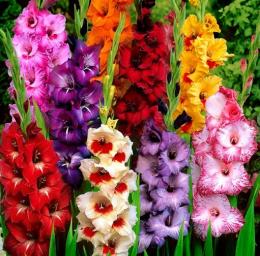
The flower received its second name “sword” from the similarity of its long narrow leaves to swords, and the stem itself, tall and straight, resembles a gladiator’s sword. It’s not for nothing that florists collect many bouquets for men from gladioli. These flowers are so popular among gardeners that there are more than five thousand varieties in the world.
It so happens that the lifespan of most varieties is no more than 10 years. But old varieties are being replaced by new ones. Each of them has its own charm and its own secrets. Even a novice gardener who loves gladioli will be able to plant and care for them.
Content:
- Gladioli, description of the species
- Selecting a location, preparing the soil for planting gladioli
- Selection of planting material, planting in the ground
- Caring for gladiolus seedlings
Gladioli, description of the species
Africa is considered the homeland of gladioli; perhaps from there the plant came to Mediterranean countries; wild species of gladioli were also found in the Asian region. The first mention of the flower dates back to the third century BC. The corms of the flower were spoken of in ancient treatises as medicinal and magical, capable of curing diseases and protecting from enemies.
They were also used for food. Interest in gladiolus as ornamental plant, appeared only at the beginning of the 19th century, it immediately gained recognition both in European countries and in America.
Gladioli belong to the bulbous perennial plants of the Iris family.
Their leaves are straight, tall, and quite rigid.At the bottom, the leaves close, clasping the stem on both sides. The stems are tall, up to 1.5 meters, solitary. The inflorescences are spike-shaped, up to 0.9 - 1 m long.
Each flower is assembled from six lobes, fused at the base, and is shaped like a funnel. The fruit is a capsule, the seeds are round, brown. Each plant produces a round, slightly flattened bulb covered in scales. The color of the bulbs can be very different, from light yellow to dark burgundy, almost black. The color of the flower petals also differs in the same variety.
Gladioli are suitable for growing both in open ground and in greenhouses; they are good both in flower beds and as cut flowers.
Selecting a location, preparing the soil for planting gladioli
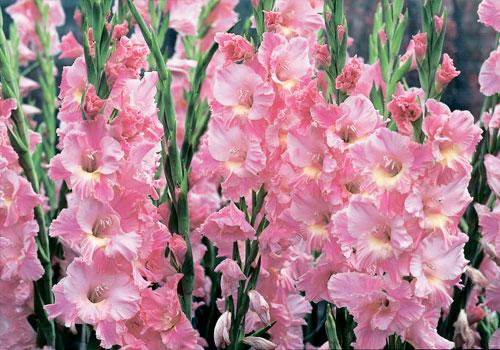
When choosing a place to place gladioli on your site, you must remember that they come from sunny Africa and they need good lighting to develop. You cannot plant these flowers in the shade of large plants on the north side. It is also necessary to provide protection from the wind.
Gladioli are enough demanding on soil. Heavy clay or peaty soil is destructive for these flowers. Sandy or loamy soils with a slightly acidic reaction, close to neutral, are best suited for them.
It is best to take care of preparing the land for planting gladioli in the fall. Autumn digging of the bed with a spade is required. At the same time, organic fertilizers are applied at the rate of ten kilograms of humus per square meter. Adding a small amount of wood ash won't hurt either.
If it was not possible to carry out this work in the fall, then it can be done in the spring, after the ground thaws.
Selection of planting material, planting in the ground
For planting gladioli use:
- seeds
- tubers
- corms
In amateur floriculture, planting seeds is practically not used. It is most convenient to purchase either young corms or use “babies”. They come in different sizes; to get flowers you need larger ones; very small ones need to be grown and they will bloom only next year.
Fine formed corms I form several replacement corms per season; they are much smaller than the main one; it is optimal to use replacement corms for planting.
Large corms have, in addition to the main one, several lateral buds. Having some experience, if necessary, to propagate a rare variety, such a corm can be divided. However, there is a risk of destroying it with careless movements.
When planting gladioli, you need to focus on the temperature of the top layer of the earth. When at a depth of 8 - 10 cm the thermometer shows at least + 8 degrees, it’s time to plant.
In most regions, the soil warms up to this temperature in late April - early May.
For planting, prepare holes 2.5 - 3 depths larger than the size of the corm. The distance between the holes depends on the size of the planting material. The larger the corm, the greater the distance. Approximately - from 10 to 20 cm. You can also dig a continuous groove and lay out the bulbs at the specified distance.
Before lowering the planting material into the hole, it is advisable to pour it well with water or a solution of phytosporin, and remove all the covering scales from the bulbs and cut off the rotten areas, if any, with a clean knife. You can pour five to six garlic cloves with hot water, cool and place the corms there for a couple of hours before planting them in the ground.
Fill the holes with loose soil and mulch with dry crumbly peat. This will protect the soil from drying out, because it is advisable not to water the gladioli before the shoots appear. If several varieties are planted, then it is necessary to mark the boundaries of each, this will help not to confuse the corms when digging them up and storing them.
Caring for gladiolus seedlings
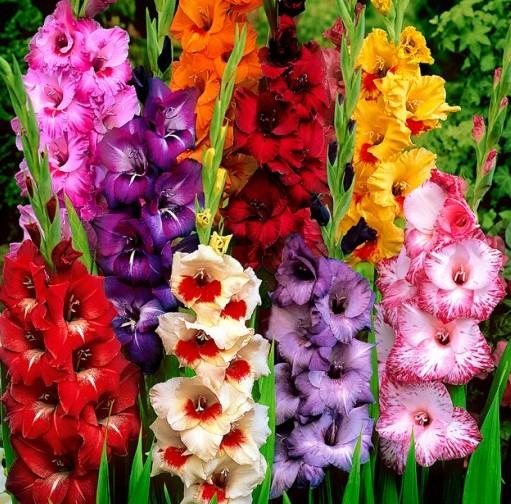
Despite its unpretentiousness, gladiolus still requires the attention of the gardener. You only need to perform a few simple agricultural techniques:
- loosening the soil
- weed removal
- fertilizing
- watering
The plants require the first watering when the ground part of the shoot reaches a height of 10-12 cm. Immediately after watering, the ground is mulched. Mulching with loose peat or humus not only protects against drying out, but also does not impede the flow of air.
One plant needs at least a bucket of water so that the moisture penetrates to a depth of at least 25 - 30 cm. Regularity of watering depends on the weather, but frequent and shallow watering harms gladioli. When watering, you must try to prevent water from getting on the leaves; for this, a watering furrow is laid in advance along a row of flowers. After each watering, after rain, and also every 10 days in dry weather, the soil must be loosened, preventing it from compacting.
During the season you will need to feed the gladioli at least five times:
- when the second leaf appears, feed with nitrogen fertilizers for the first time
- when the fourth leaf appears, apply a second feeding
- third feeding after the appearance of the fifth leaf
- feed with phosphates for the fourth time when buds appear
- at the beginning of September the last feeding is carried out
Weeds are removed at least two to three times, and if necessary, weeding will have to be repeated up to 4 to 5 times during the summer. Weeding is a good prevention of many diseases of gladiolus, the key to abundant and long flowering.
For beginning flower growers, gladioli with early and medium flowering periods are suitable; late varieties may not have enough time to bloom buds. If you have no experience, you should pay attention to the following varieties of viable varieties:
- golden antelope
- City of Kitezh
- Heart of Russia
- Revenge
- Amber Baltic
Can be planted several varieties and do not be afraid of cross-pollination, this will not happen when planting gladioli with corms. Love for these flowers, following simple rules, will result in the appearance of beautiful inflorescences.
Detailed video about planting gladioli and caring for them:
Interesting information about the vegetable garden


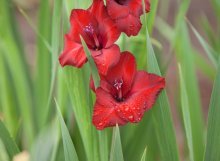


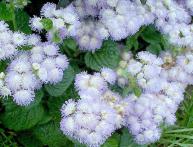

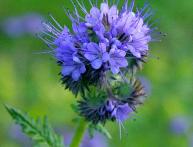

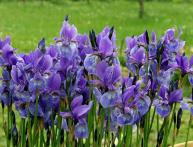

Comments
I love gladioli. Ours grows a little, but the problem is that they are so fragile and you have to constantly tie up the flowers, otherwise it’s just wind or rain and they all lie on the ground.